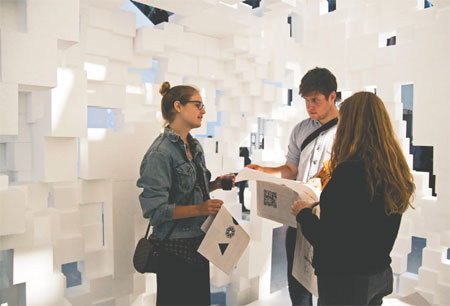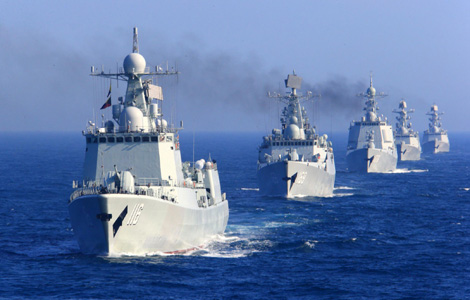Routes across the Pacific Ocean
Updated: 2013-07-19 11:29
By Kelly Chung Dawson in New York (China Daily)
|
||||||||
|
Visitors take in "The Crystalline World: SUBHEDRAL," art work by Thom Faulders and Lynn Marie Kirby included in the new exhibition "Electronic Pacific" at San Francisco's SOMArts Cultural Center. Kelley Bennett / for China Daily |
A Western-centric view of the world has long dictated that the often-repeated slogan of the Gold Rush days -"Go West" - referred to California, and those traveling to the East had bypassed the other coast and were en route to China. But a new exhibition poses the question: What if the Pacific Ocean was the center?
"So much of our language is rooted in the legacy of colonialism and Western history, but today you see people who move between San Francisco and Shanghai more readily than between San Francisco and New York," said Justin Hoover, curator of the exhibition Electronic Pacific, opening this weekend at San Francisco's SOMArts Cultural Center. "Today, due to global digital telecommunication, one could redraw cultural maps to conceptualize the West Coast of the United States as the East Coast of the Pacific Ocean. New modes of communication can operate in a supra-national modality to swiftly redefine cultural norms."
Featuring 26 artists and split between two gallery spaces, Electronic Pacific includes eight artists with a focus on China. Tying the work together is a theme of digital communication and the liminal space created by cultural mistranslation.
Utilizing Google Translator, Guangzhou artist Xiaopeng repeatedly translates the rhetoric of Chinese politicians into English and back, until the words have become nonsense, the intended meaning lost to the limitations of technology.
Accompanying this work is a series of videos, in which the artist has translated the lyrics of hip-hop artists to highlight the potential for misunderstanding of another nation's pop culture.
Jenny Odell, a so-called "cameraless photographer," isolates objects, buildings and landmarks affiliated with trade and transport from all over the world using Google Satellite View. Stripped of the context of surrounding markers, the objects form a visual archive of unfamiliarity.
"These artists are pushing the medium of digital translation and communication to see where they fail," Hoover said. "With the ubiquity of cutting-edge technology in the art field now, we're all babbling together in an interesting poetic space. Technology doesn't necessarily always bring us together to connect; it also enables us all to speak louder. In many ways, everyone's just talking over each other. There's a deterioration of understanding at the edge of language and technology, a frayed edge that is both challenging and beautiful."
In a continuation of her work with the artists of China's Xiamen art reproduction village, Lizabeth Eva Rossof commissioned nine self-portraits by oil painters who make a living creating the frequently overlooked art that fills hotel lobbies, doctors' offices, and restaurants all over the world. The paintings created by the artists in Chinese reproduction villages provide 80 percent of the canvas art commercially available worldwide, Rossof said. Asked to turn their focus to themselves, the artists often struggled with the sudden creative freedom afforded by Rossof.
Working with a translator, Rossof spoke with the artists about their lives, which proved surprisingly familiar, she said. Like Rossof, some of the artists battle between the urge to create and the need to pay rent. Later, she watched professional translations of the videos of her interviews and realized that the discussions were more nuanced than she had realized at the time. Some of those interviews are presented in an accompanying 14-minute documentary titled Master Copy.
"I just wanted to see what would happen, what would it look like if someone who paints Mona Lisa all day long, had the opportunity to paint themselves," Rossof said. "In the end, it was funny to see that the man who's famous for painting Mona Lisa reproductions painted the draping of his T-shirt in such a way that it reminded me of the drapery in the Mona Lisa. With all their training, these painters have often never thought of themselves as a possible well of inspiration or subject matter."
Western consumers rarely stop to think about the human hands that have been intimately involved with almost everything we buy, she said.
"On a daily basis, our entire lives and our bodies are literally wrapped in items from China," she said. "Think about the stitches, the material and the people who have put their personal prints on the things in your life. It's important to reflect on that. I wanted to give a literal face to those people in the self-portraits."
"Maybe the Pacific Ocean itself is the center, or maybe it's one of the centers," Hoover said. "Maybe there's a multiplicity of centers. The language is changing as the way we think about the world changes and directionality becomes less important."
An Xiao Mina, a digital artist who has worked in both China and the US, explores the connections between animated online "gifs" (short animated images that are increasingly popular on the internet) and the ancient cave paintings of Frances's Lascaux Caves, which were intended to be viewed under the shape-shifting glow of torchlight.
Although an exhibition like Electronic Pacific can be described as an attempt to bridge gaps between East and West, Mina believes that the "bridge" analogy is less and less relevant in describing cultural exchange.
"Bridging implies that there are only a few ways to get across, but as more people are engaging in dialogue across the ocean, maybe the entire Pacific is a way to get there and back," she said. "There are unlimited ways to travel that gap now."
kdawson@chinadailyusa.com
(China Daily USA 07/19/2013 page11)

 Rat, rabbit head sculptures on display
Rat, rabbit head sculptures on display
 Russia jails opposition leader
Russia jails opposition leader
 Detroit files biggest ever US municipal bankruptcy
Detroit files biggest ever US municipal bankruptcy
 Plane crash victims' parents seek answers
Plane crash victims' parents seek answers
 'Improving' Mandela marks 95th birthday
'Improving' Mandela marks 95th birthday
 Qingdao eatery finds use for pesky seaweed
Qingdao eatery finds use for pesky seaweed
 From university campus to boot camp
From university campus to boot camp
 FIFA head: World Cup in Brazil could be mistake
FIFA head: World Cup in Brazil could be mistake
Most Viewed
Editor's Picks

|

|

|

|

|

|
Today's Top News
Monetary system needs overhaul, says report
US companies seek tougher enforcement of IP laws
Syrian refugees demand help from Kerry at camp
Second iPhone shock leaves man in coma
China's government spends less in 2012
Pregnant Olympic runner dies, baby saved
Detroit files biggest ever US municipal bankruptcy
Obama weighs canceling Moscow talks with Putin
US Weekly

|

|








